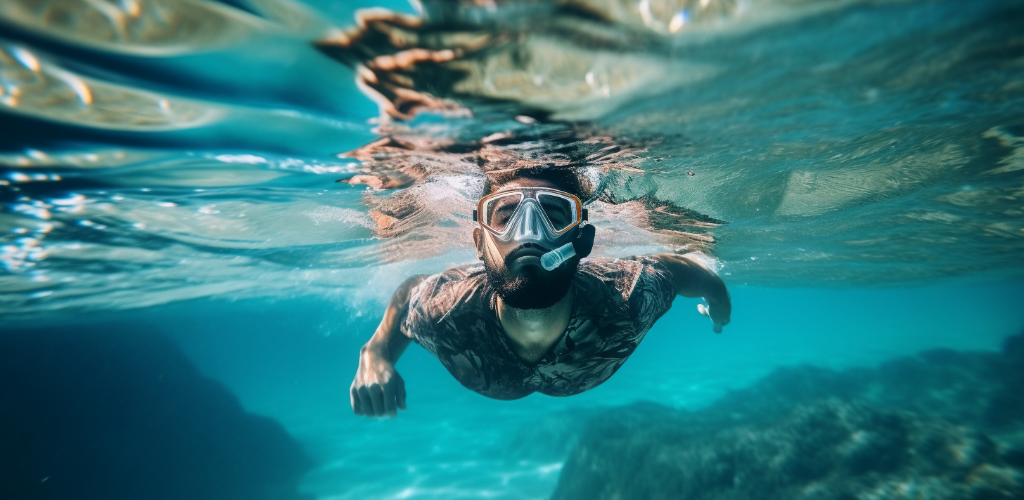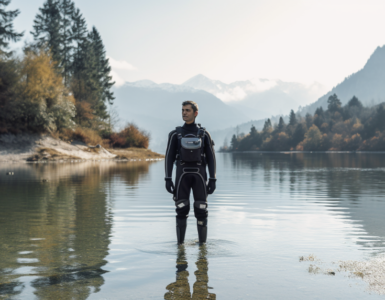Have you ever wondered how snorkels work? If you are a fan of water sports or simply an enthusiast of the undersea world, understanding the mechanics of a snorkel is essential. Snorkeling is a fantastic way to explore the underwater world, and the snorkel is your lifeline, your connection to the world above the water. But, how does this simple piece of equipment work? Let’s dive in and find out!
With the right knowledge, you can make the most of your snorkeling adventures. So, are you ready to explore the incredible engineering behind the humble snorkel? Let’s get started!
Understanding what a Snorkel is:
A snorkel, at its simplest, is a tube that allows divers to breathe underwater. But it’s not just any tube. It’s a specially designed piece of equipment that enables you to explore the undersea world without constantly surfacing for air. Sounds fascinating, doesn’t it?
Without a snorkel, you’d have to keep coming up for breath, which would disrupt your underwater experience. That’s why snorkels are a favourite among divers – they keep you in the thick of the action without interruption.
The Essential Components of a Snorkel:
Let’s break down the snorkel into its essential parts: the tube, mouthpiece, and purge valve. Each component plays a critical role in making the snorkel work.
The Tube is the most visible part of the snorkel. It’s the long, curved piece that sticks up above the water, providing an air passage to the diver’s mouth. The mouthpiece is the part that you bite down on to secure the snorkel in your mouth. It’s typically made of soft, flexible silicone to ensure comfort during use. Lastly, the purge valve is a one-way valve located at the bottom of the snorkel. It allows any water that enters the snorkel to be easily blown out, clearing the airway.
Understanding the role of each component not only helps you understand how a snorkel works, but also enables you to troubleshoot any issues that may arise during your underwater adventures.
The Science Behind How a Snorkel Works:
Ever wondered how a simple tube can make underwater exploration possible? Let’s break it down. The science behind snorkeling is surprisingly straightforward, yet ingenious. It’s all about leveraging the basic principles of physics and human physiology to enable us to breathe while partially submerged in water.
The Role of the Tube:
The tube plays a crucial role in the snorkeling process. It essentially acts as an extended airway, allowing you to breathe while floating face-down on the water surface. It extends above the water, ensuring a constant supply of fresh air. The tube’s length and diameter are carefully designed to ensure sufficient air flow. Too long or too narrow, and it would be difficult to inhale and exhale effectively. Isn’t it fascinating how such a simple device can harness the basic laws of physics?
The Function of the Mouthpiece and Purge Valve:
The mouthpiece and the purge valve are two other key components of a snorkel. The mouthpiece is typically made of soft, flexible silicone that fits comfortably and securely in the diver’s mouth. It creates an airtight seal and directs the air flow from the tube into the diver’s lungs.
Now, what about the purge valve? This clever feature is designed to help divers clear any water that might enter the snorkel. Ever imagined having to surface and remove your snorkel just to drain out the water? That’s where the purge valve comes into play. It’s a one-way valve at the bottom of the snorkel. When you exhale forcefully, the valve opens, expelling any water that has collected in the tube. Now that’s one less thing for you to worry about while enjoying the underwater sights!
| Component | Function |
|---|---|
| Tube | Provides an air passage above the water surface, enabling the diver to breathe while face-down in the water |
| Mouthpiece | Creates an airtight seal in the diver’s mouth, directing the airflow from the tube into the lungs |
| Purge Valve | One-way valve that allows divers to clear out any water that enters the snorkel by exhaling forcefully |
Different Types of Snorkels:
Snorkels come in a variety of shapes and sizes, each designed to meet specific needs and preferences. But did you know there are different types of snorkels out there, each with unique features and benefits? Let’s dive right in and explore!
J-Tube Snorkel:
The J-tube snorkel, also known as the classic snorkel, is the simplest form. It’s a basic, curved tube with a mouthpiece. Its straightforward design makes it a popular choice for many divers.
Dry Snorkel:
A dry snorkel, on the other hand, has a special valve at the top that prevents water from entering the tube. This feature makes it an excellent choice for divers who want to avoid the inconvenience of constantly clearing water from their snorkel.
Semi-Dry Snorkel:
Semi-dry snorkels are a hybrid between the classic J-tube and the dry snorkel. They feature a splash guard at the top to prevent water from waves or splashes from entering the snorkel, but they don’t completely seal off like dry snorkels when submerged.
Full-Face Snorkel:
Lastly, we have the full-face snorkel. This type of snorkel comes with a mask that covers the entire face. It allows divers to breathe through both their nose and mouth, offering a more natural breathing experience. Additionally, the wide field of vision is a big plus for those who want to fully enjoy the underwater scenery.
- J-Tube Snorkel: Simple and straightforward design
- Dry Snorkel: Features a valve that prevents water entry
- Semi-Dry Snorkel: Hybrid design with a splash guard
- Full-Face Snorkel: Covers entire face, allows natural breathing
The Right Way to Use a Snorkel:
Now that we know about the different types of snorkels, let’s talk about how to use them. Using a snorkel might seem simple, but it’s important to get it right to ensure a safe and enjoyable diving experience.
Firstly, the snorkel should be positioned on the left side of your mask, securely attached with a clip. This traditional placement comes from the days when divers used to carry spears in their right hands, and it has stuck around ever since.
Wondering how to breathe through a snorkel? It’s all about slow, calm breaths. Breathe in and out through your mouth, keeping your breaths slow and controlled to prevent hyperventilation.
What if water gets into your snorkel? Don’t panic! It’s normal and can easily be cleared by exhaling forcefully through the snorkel, pushing the water out. If you’re using a dry or semi-dry snorkel, the valves and splash guards will help minimize water entry.
Remember, practice makes perfect. So, before you head out to explore the underwater world, practice using your snorkel in a controlled environment like a swimming pool. Happy snorkeling!
Common Misconceptions About Snorkels:
When it comes to snorkels, a number of misconceptions abound. One of the most common misunderstandings is the belief that a snorkel allows divers to breathe underwater indefinitely. While snorkels do provide an extended airway to the surface, they do not enable you to breathe underwater like a scuba diver. This is because the snorkel tube cannot be longer than your lung’s capacity to pull air down. Isn’t it fascinating to clear our misconceptions?
The Limitations and Risks of Using a Snorkel:
Snorkels are fantastic tools, but like any other equipment, they have their limitations and risks. One key limitation is that you cannot breathe through a snorkel if it’s submerged entirely under water. This is a huge risk for those who are unaware or unprepared. Another potential risk is the possibility of panic if water enters the snorkel. It’s essential to understand how to clear the snorkel properly to prevent such situations. So, are you ready to be a responsible snorkeler?
Snorkeling Safety Tips:
Now that we understand the workings, limitations, and risks of snorkeling, let’s wrap up with some safety tips. Remember, knowing how to use your gear is just as important as having fun underwater!
- Get proper training: Before you head out, ensure that you receive appropriate training. This will equip you with the skills to handle any situation that may arise.
- Understand your equipment: Get to know your snorkel. Understand its functions, limitations, and usage to make your underwater adventures safe and enjoyable.
- Check your gear regularly: Regularly inspect your snorkel for any signs of damage or wear and tear. A well-maintained snorkel is a safe snorkel!
- Practice clearing your snorkel: Learn and practice how to clear your snorkel. This skill is crucial if water enters your snorkel.
- Never snorkel alone: Always snorkel with a buddy. It’s not just more fun; it’s also safer.




